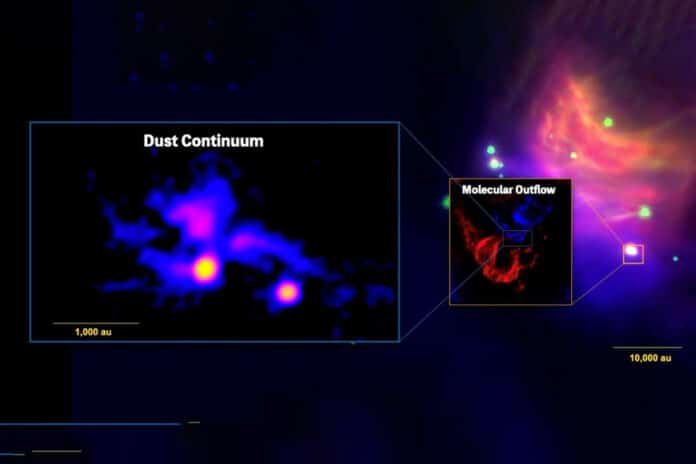One poorly understood aspect of low-mass star formation is how multiple-star systems are formed. Building comprehensive models of star formation and planet formation requires understanding how multiple star systems come into existence.
The “dense core” of the molecular cloud, which contains the densest gas, is where all stars are born. According to earlier observations, a stellar system has more “star babies” the less space they occupy overall. Due to a lack of observations, it is unclear how higher-order stellar systems with more than two stars are generated in dense cores.
Extant models suggest that multiple star system forms via the fragmentation of a cloud core in its early evolution. To explore the origin of multiple star systems, the international team ALMA Survey of Orion Planck Galactic Cold Clumps (ALMASOP) conducted a high-resolution investigation on 72 dense cores in the Orion Giant Molecular Clouds (GMCs) with the Atacama Large Millimeter/submillimeter Array (ALMA).
They discovered a forming quadruple-star system within one core. At a wavelength of 1.3 mm, scientists noticed dust thermal emission. They found a quadruple protostellar system in the Orion B GMC’s dense cold core G206.93-16.61E2, 1,500 light-years from Earth. Four objects make up the system: two protostars, two prestellar gas condensations, and two potential low-mass stars.
Ph.D. LUO Qiuyi at SHAO and the study’s first author said, “The exceptional compactness and close proximity of this system is a fascinating discovery. The analysis suggests that this system will likely form a future gravitationally bound quadruple star system.”
Scientists discovered that the largest separation of the four members in the system is only one thousand astronomical units. They also found several ribbon-like elongated structures in dust emission, tightly binding the four members together and extending outward.
To determine the involvement of the continuum ribbons, scientists compared the numerical simulation of a similar quadruple system to the empirical data. They discovered that the extended continuum ribbons could function as conveyance funnels, moving gas materials from the outer envelope/core down to the protostars and acting as gas bridges connecting the newborn member stars.
Prof. LIU Tie from the Shanghai Astronomical Observatory (SHAO) of the Chinese Academy of Sciences said, “The simulation supports that these ribbons can serve as large-scale accretion streamers. Thus, the two gas condensations in the system have the potential to form a star relying on the feeding of these continuum ribbons. The accretion streamers could also fragment and further form new stars.”
Furthermore, the studies revealed intricate gas outflows caused by the system’s protostars, which could be viewed from a pole-on perspective. Some materials given by accretion flows are lost via outflows in the crowded natal environment, which may impact the evolution of their system.
Ph.D. LUO said, “We do not have an explanation for how the gas outflows propagate as they might be entangled with gas accretion processes of system members. This study highlights the complicated interactions among members in a forming higher-order star system.”
This study gives strong evidence that a quadruple system exists. Future ALMA exploration has the prospect of revealing more features, advancing our understanding of the journey of multiple-star system formation.
Journal Reference:
- Qiu-yi Luo et al., ALMA Survey of Orion Planck Galactic Cold Clumps (ALMASOP): A Forming Quadruple System with Continuum “Ribbons” and Intricate Outflows, The Astrophysical Journal Letters (2023). DOI: 10.3847/2041-8213/acdddf
